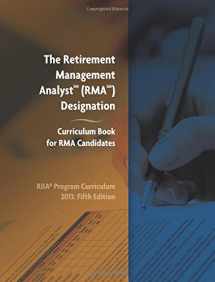
The Retirement Management Analyst (RMA) Designation: Curriculum Book for RMA Candidates
ISBN-13:
9781493585397
ISBN-10:
1493585398
Edition:
Five
Author:
François Gadenne
Publication date:
2013
Publisher:
CreateSpace Independent Publishing Platform
Format:
Paperback
472 pages
FREE US shipping
Book details
ISBN-13:
9781493585397
ISBN-10:
1493585398
Edition:
Five
Author:
François Gadenne
Publication date:
2013
Publisher:
CreateSpace Independent Publishing Platform
Format:
Paperback
472 pages
Summary
The Retirement Management Analyst (RMA) Designation: Curriculum Book for RMA Candidates (ISBN-13: 9781493585397 and ISBN-10: 1493585398), written by authors
François Gadenne, was published by CreateSpace Independent Publishing Platform in 2013.
With an overall rating of 3.7 stars, it's a notable title among other
books. You can easily purchase or rent The Retirement Management Analyst (RMA) Designation: Curriculum Book for RMA Candidates (Paperback) from BooksRun,
along with many other new and used
books
and textbooks.
And, if you're looking to sell your copy, our current buyback offer is $0.37.
Description
This book provides an advanced education combining a scientifically-based and practitioner-developed, retirement-income planning curriculum in support of earning the Retirement Management Analyst (RMA) designation. The RMA designation, created by the Retirement Income Industry Association (RIIA), is a rigorous educational and ethics training that focuses on building the retirement plan to mitigate risks and to master the retirement-planning advisory process. Financial professionals who take and pass the examination to earn the RMA designation are uniquely prepared to deliver retirement-income solutions and services to clients who want a secure income stream and ongoing professional management throughout their retirement years. This book is intended for financial professionals, including: asset managers, licensed agents and representatives of broker/dealers, registered investment advisors, and certified financial advisors (both in the retail and the employer-sponsored plan sectors). These professionals can expect this book to help them: - Organize their thoughts about their clients’ financial situations - Reach conclusions about their clients’ retirement-income needs - Recommend appropriate retirement-income plans - Explain why the plans make sense - Implement the plans by changing the clients’ allocations to risk-management techniques, thus enabling them to purchase a better mix of products - Take the examination for RIIA’s RMA designation The focus of the book is to “Build a Floor and Create Upside Potential.” Most investment professionals specialize in managing client assets, with an eye toward maximizing accumulation during the clients’ working lives. The duties of Retirement Management Professionals, however, are broader. These advisors need to manage their clients’ complete household balance sheet assets and liabilities as well as the matching cash flows, with an eye toward minimizing a broad range of risks during their clients’ retirements. RIIA developed a hub-and-spoke framework to organize retirement-income solutions. The framework has seven chapters – a hub, five spokes and an integrative process. The client is the hub, and the spokes are the steps in a process of integration and monitoring. RIIA calls them “spokes” rather than “steps” for two reasons. First, they represent a cyclical process of interaction with the client that has no specific beginning or end. Secondly, each one strengthens the relationship between advisor and client. The objective is to identify the proper, client-matched strategies that will build a floor and create upside potential. RIIA assumes that, during retirement, clients will need a customized level of income (“a floor”) from guaranteed or low-risk sources, as well as the potential for growth through exposure to risky assets (the “upside”). One size does not fit all. Building a portfolio for retirement income isn’t necessarily harder than building a portfolio for asset accumulation, but it does require a deeper assessment of the client’s needs. The investment of more time at the beginning of the relationship can pay off, however, in the creation of satisfied clients whose assets will be “stickier” and who will bring additional advisory opportunities.


We would LOVE it if you could help us and other readers by reviewing the book
Book review

Congratulations! We have received your book review.
{user}
{createdAt}
by {truncated_author}


